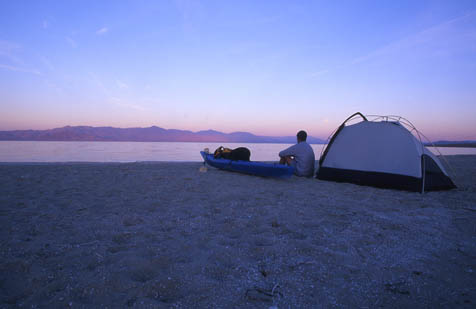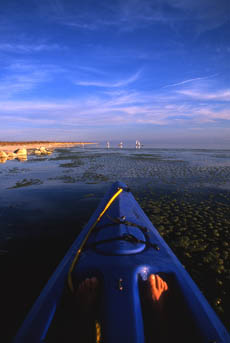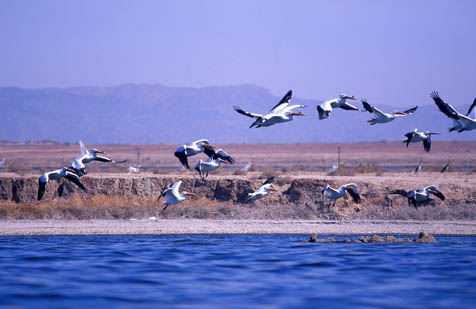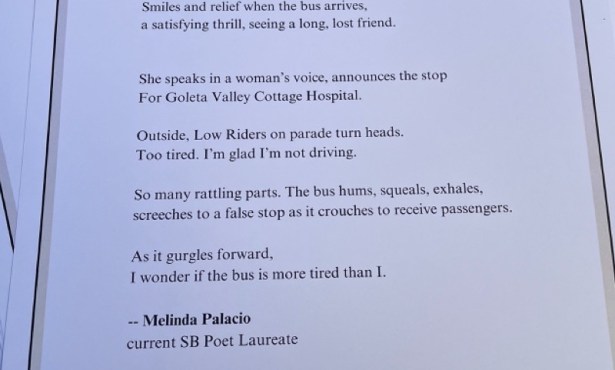Kayaking the Salton Sea
Thicker Than Blood

Since kayaking is a favorite mode of travel of mine, I was curious about exploring Salton Sea, California’s largest inland lake, which sits 228 feet below sea level in the Colorado Desert. Not dissuaded by its occasional piercing sulphuric stench, schools of dead fish, or stinging sandstorms, I drove up to its eastern shore and unloaded my gear, before paddling six miles southeast to a sparsely advertised kayak camp known as Salt Creek.
It was comfortably warm when I put in an hour before dark, avoiding that midday desert heat. The Salton Sea’s 360 square miles was so glassy it was soupy smooth. My feet crunched across the briny barnacled clusters as I tiptoed into the warm water. The first thing I noticed about this sea was its buoyancy compared to the ocean. Only my heels were wet in my sit-on-top kayak. That’s because the Salton Sea is currently 25 percent saltier than the ocean, and apparently getting saltier by the day. There’s an estimated 500 million tons of salt in the sea; scientists are concerned that even a small increase in salinity could disrupt the ecological balance of this supposed human-made gaffe.
As I glided by the boat launch, it became evident my kayak was the only watercraft on the sea. A large sandbar had developed at the mouth of the launch, blocking any boat traffic. It was me and the fish in this avian paradise between Joshua Tree National Park and Anza-Borrego Desert State Park. I paddled among tall stands of herons and egrets, flocks of gulls, scurrying shorebirds, and magnificent American white pelicans that I called the “white mirage.”

The Salton Sea is increasingly important to the Pacific Flyway because more than 92 percent of the wetlands that provided habitat value to birds along this migration route in California have disappeared. Several million birds migrate and inhabit the region every year. More than 400 species of birds have been spotted at the Salton Sea, more than any other place in the U.S. other than the Gulf Coast of Texas.
The abundance of fish introduced to the Salton Sea plays an important role in the prolific bird life in this desert oasis. Tilapia, Gulf Croaker, Orange Mouth Corvina, and Sargo can all be had, while the endangered pupfish is the only native species in the desert.
Around 10,000 years ago, numerous floods formed the ancient Lake Cahuilla, which was more than twice the size of the Salton Sea. Cahuilla actually stretched far beyond where the sea is today to the Mexican border, but disappeared for good 300-500 years ago.
In 1905, a swollen Colorado River spilled over, breaking through irrigation canals for 18 months and flooding the Salton Basin. Today, runoff and agricultural drainage from 500,000 acres of farms sustain the vitality of the sea, which is a terminal lake, meaning it possesses no drainage outlets.
Pesticides are not found at any significant level in the sea. Pesticide levels are periodically found to be high at some drainage points, but the sea’s sheer volume and most pesticides’ ability to biodegrade seems to limit their impact, which doesn’t explain the massive periodic die-offs of fish and bird disease outbreaks. Speculation swirls around increased salinity, nutrient-rich water, and algal blooms, but to most, the Salton Sea remains a mystery.
I saw no sign of death while paddling along the eastern shore. With the sun sinking behind the Santa Rosa Mountains to the west, and not a ripple of water out of place, the sea came to life. Scores of fish breached the salty surface and thousands of birds foraged for food and bathed in the glowing light of a desert sunset.
Desert Nirvana
The best time to paddle in the desert is at first light to avoid the sweltering heat. The full moon was so bright I didn’t need my headlamp as I quickly broke camp, wolfed down an energy bar, and pushed off from a narrow peninsula heading due south.
My expectations of a kayak camp in the Colorado Desert were about as high as the flat desert horizon, with its pinkish hues fading with the rising sun. However, after paddling for only an hour toward the sun, its penetrating rays were already beating down on me. A half mile further and a dry, gaping canyon opened up like a gritty wound in the desert escarpment. Thoughts of posting up within the shade of a canyon wall crossed my mind, but I spotted a white sign a quarter mile farther. My anticipation increased with each stroke of my paddle. As I drew closer, the kayak camp revealed itself. The sign read, “Kayak Camp, Salt Creek, Salton Sea Recreation Area.”

As I walked off the minor stiffness in my legs, I found picnic tables, a rack for stacking kayaks, showers, toilets, drinking water, barbeques, and shade. This was a potential beer commercial in the making amid the heat in a seemingly lifeless desertscape. Two years ago, the California Department of Boating and Waterways put $91,000 into erecting camps along the Salton Sea, thus making kayaking the best, most unique way to explore this vital resource.
I pitched my tent on the beach and relaxed at one of the picnic tables out of the sun, while watching the assemblage of birds flying and foraging along the shore. The silence was intoxicating.
The next morning, sitting up in my tent, I sleepily gazed at shades of purple sweeping across the Santa Rosa Mountains, 15 miles to the west, my desert wakeup call. As I loaded my kayak, a dark, cobalt-blue line developed across the western shore and grew closer by the minute. By the time I began paddling back to my truck, the wind line was only a half-mile away.
Ten minutes later, I was experiencing the punch of the notorious desert winds, and although it kept the temperature at bay, paddling became laborious in estimated 25-knot winds. Victory at Sea conditions prevailed for three hours back to my truck. Whitecaps spilled over the bow of my boat, and after the first hour, enough salt had accumulated on me that I couldn’t read my watch anymore. In fact, my entire kayak, my dry bags, and I were smothered in a thick layer of crunchy salt.
When I finally felt the hull of my kayak scrape barnacles for the last time, the layer of salt cracked as I stood up out of my boat. I tossed my paddle aside and jogged to my truck, a monstrous RV parked alongside it. A portly fellow, with coffee and doughnut in hand greeted me.
“Hey, you look like one of these,” he said, holding up his half-munched glazed doughnut.



